
Highlight: Lavish Bhutan wedding with sacred religious traditional blessing, photography, Bhutanese traditional costumes, blessing by buddhist masters, special ceremony in a sacred ancient temple.Bhutan tour and wedding photography.
Description : Bhutan has a unique cultural heritage which has its roots in Buddhism. The Bhutanese people have successfully kept its culture and traditions intact until this day.
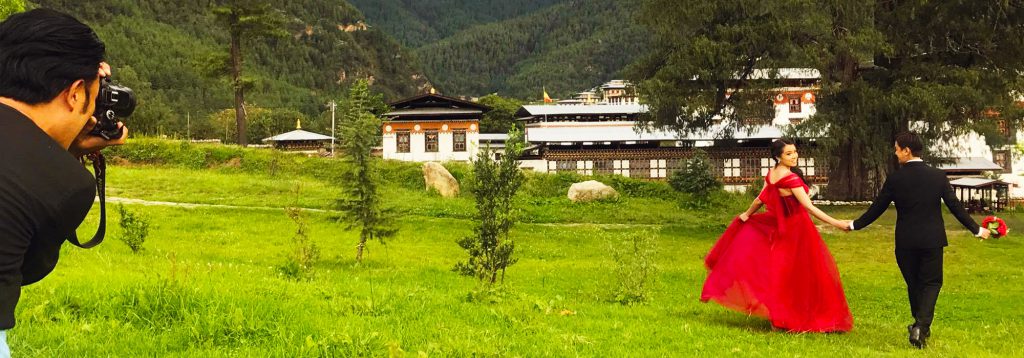
Spirituality exists in everyday life of Bhutanese people, therefore in Bhutan a wedding is a celestial union of mind, body and soul of two people. Bhutan has became one of the most popular wedding country now, with celebrities and some of the most popular people visiting Bhutan to have their blessed wedding vows in Bhutan.
One of the most renowned person who got proposed and got married in Bhutan is Dew Aung San Su kyi at Tigers nest temple, Hong kong celebrities Carina Lau and Tony Leung Chiu Wai and the list goes on.
Wedding Location : Wedding can be an ancient temple temple ( 1000 year sold sacred temple/shrine ), Resort in or 300 years old heritage Bhutanese home.
Location tours: Thimphu (capital ), Paro valley and Punakha valley.
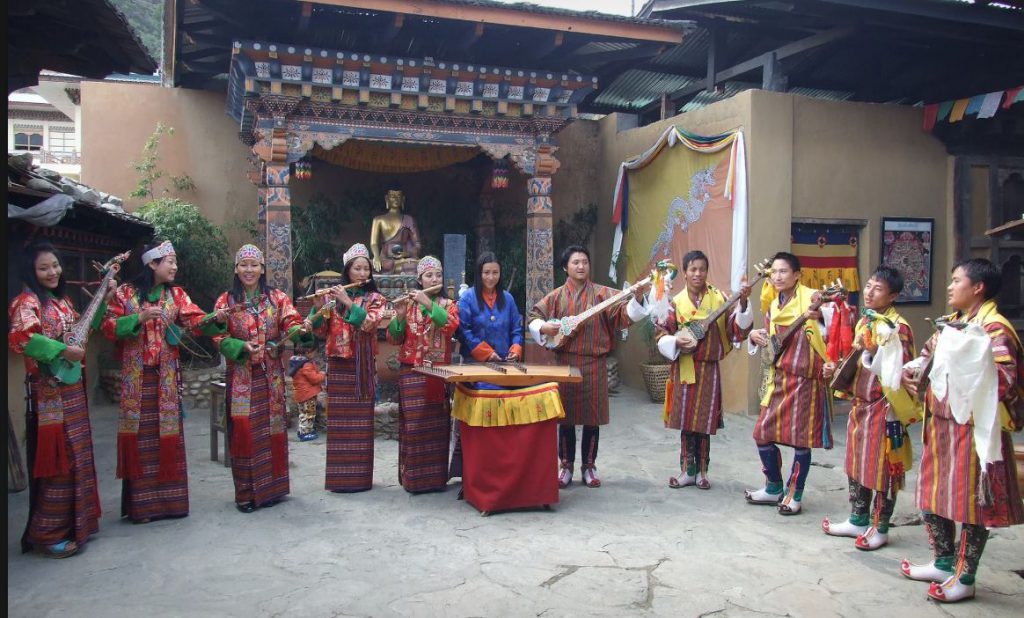
Fly into Paro, the great snow-capped peaks of the inner Himalayas rise up to the heavens can be seen during clear weather. As the plane approaches Bhutan, if you look down farmhouses as dots on the hillsides can be seen.
As the aircraft enters the Paro valley, you will see Paro Dzong on the hillside overlooking the Paro Chu (river), with Ta Dzong, formerly a watch tower and now the National Museum, above it.
You will be received by the representative of Bhutan, who will be your Bhutan travel guide throughout your tour.
Visit the following:
Overnight at a hotel in Thimphu.
After breakfast Thimphu sightseeing’s includes the following:
After 5 PM we will visit the Tashichho Dzong, “the fortress of the glorious religion”.
This is the centre of government and religion, site of the monarch’s throne room and seat of the Je Khenpo or Chief Abbot. Built in 1641 by the political and religious unifier of Bhutan, Shabdrung Ngawang Namgyal, it was reconstructed in the 1960s in traditional Bhutanese manner, without nails or architectural plan.
Night halt in Thimphu.
Today we will dress up the couple in exotic Bhutanese costumes and prepare them for the wedding. We will then drive to one of the holiest shrines in Thimphu and make the vow arrangements;
The Head monk will preside over the rituals and offer the scarves to the couples. “Bhutanese wedding is much more than an exchange of vows and rings.
It includes a number of religious rites performed by Buddhist monks and lamas. This represents the importance of the bond between two people. This ceremony is also used for renewing marriage vows.
The actual wedding ceremony and blessings for a lifetime of love and happiness takes place at home. This is followed by visits to sacred temples to make more offerings.
Lhabsang purification : The ceremony begins with a ritual in the morning performed by the monks before arriving at the temple.
Butter lamp : Butter lamps are lit inside the temple as an offering to the deities. Before lighting the lamps the bride and groom have to prostate six times; three times to the head monk and three times to the main alter.
Thrisor : Thrisor is a rite of purification and cleansing that is performed by the head monk at the temple. This will clear your bodies, minds, and speech of all past sins
During the ceremony, monks recite mantras and offer fumigation outside the temple to please the local deities. Bhutanese believe that only if the local deities are pleased we can have their blessing and enjoy good health and wealth.
The fumigation is to please their sense of smell and grains added to the fumigation are to quell their hunger. Inside the temple butter lamps are lit and prostrations done. The butter lamps are an offering of light to deities and the most common means of increasing merit.
Changphoe : The offering to the gods and deities in a form of liquor. After an offering is made to the deities, the liquor (ara) will then be served to the bride and the groom in a traditional wooden phop. (cup), which they will share. This symbolises the faith and everlasting bond the husband and the wife will share for the rest of their lives.
Tsephamey Choko : Tsephamey Choko is a long ritual that is performed in honor of Tsepamey; the God of longevity. It is performed by the head monk to give you a long and happy life together. It is followed by the bride and groom being blessed by the head monk.
Zhugdrey Phunsum Tshogpa : Food and drinks are now offered to deities and the people at the ceremony. This represents unity, wealth, and glory, and in no way should be refused. Normally oranges are used, as they are attractive, taste good, and represent unity. As well, the actual fruit is protected under a layer of skin, which symbolizes security and protection.
Dhar Nayanga : This is the last part of a Bhutanese wedding. Five colored scarves are given to the bride and groom as well as wishes for a happy, prosperous, and everlasting marriage
In addition to these traditions, the bride and groom should be wearing traditional Bhutanese costumes to show respect for this sacred ceremony. This means that the bride will wear a Kira and the groom will wear a Gho.
Option: After the wedding we will drive to the Bhutan post office and take photo to make Stamps of the wedding, which us usable in any part of the world.
We will be driving to some of the best spots in Capital (Temples, mountain side and other beautiful landscapes to take photo of the couple who will be dressed colorfully.
In the evening we will have dinner in one of the Heritage Farmhouse/or simply Bhutan restaurant in Thimphu and also a private 1 hour cultural program will be organized for the married couple.
The beautiful day will finish with great Bhutanese authentic food and traditional Bhutanese Ara/Wine.
Overnight in Thimphu.
Sightseeing and Photo shoot at the Dochula Mountain pass (Half day photo shoot )
After breakfast, travel to Punakha through Dochula Pass (3,088m/10,130ft). If you have a clear sky, the view of the Himalayan Mountain ranges spectacular and you can even see the Gasa Dzong as a white dot in the horizon.
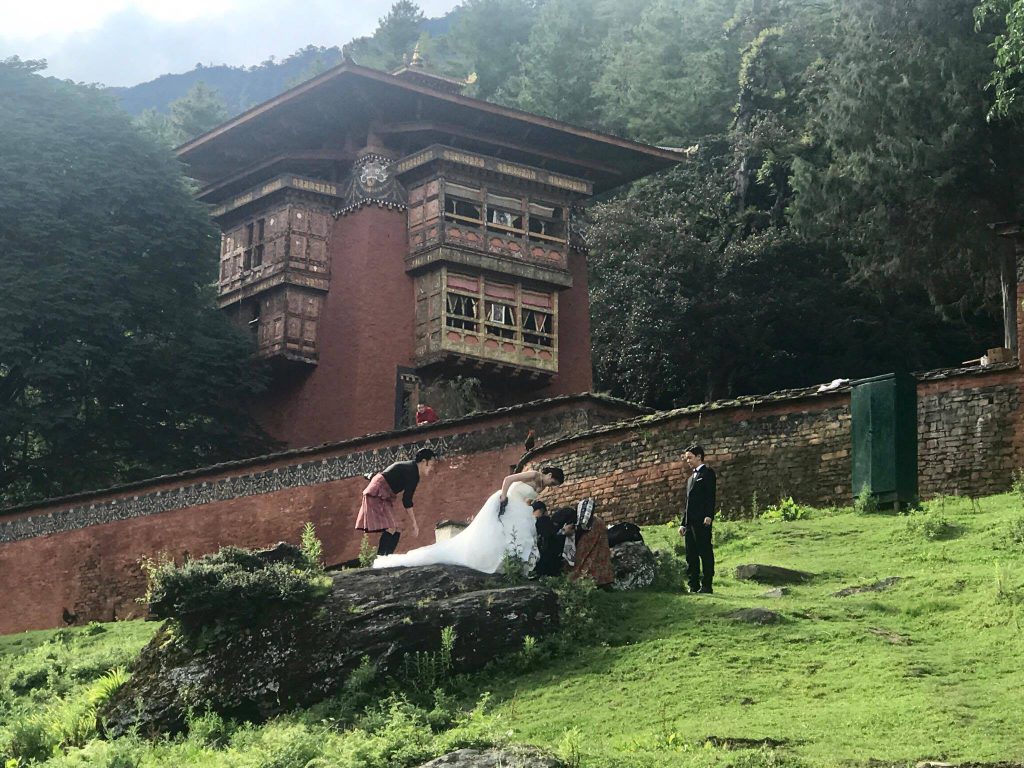
Visit the beautiful 108 chortens built on the hill by Her Majesty Ashi Dorji Wangmo for the security and well being of His Majesty the King of Bhutan.
Travel onto Punakha, the old capital of Bhutan and presently the winter residence of the central monk body.
Visit the Punakha Dzong, located on the island of the Pho – Chu (male) river and the Mochu (female) river. Evening, walk through the Metshina Village and take a 20 minute walk through the rice fields to the Devine Madman’s Monastery-Chhimi Lhakhang, famously known for its fertility shrine, where one can receive a special fertility blessing .
Overnight at a hotel in Wangdue/Punakha.
After breakfast, we will drive to Paro. Visit Kichu temple, one of the 108 temples built in the 7th century by the Tibetan King Songsten Gampo.
The story goes that a giant demon lay across the whole area of Tibet and the Himalayas and was preventing the spread of Buddhism. To overcome her King Songtsen Gampo decided to build 108 temples, which would be placed on all the points of her body. Of these 108 temples, 12 were built in accordance with precise plans.
Thus, it happened that in about the year 638 AD the temple of Jokhang in Lhasa was built over the very heart of the demon.
In the afternoon stop in Paro town and visit some of the popular coffer house and relax.
Night halt in Paro
After breakfast, drive up to the base camp of Taktsang and then hike up to the most famous Monastery in the entire kingdom of Bhutan perched on the edge of a steep cliff, about 900 meters above Paro Valley. The hike to the viewpoint will take about an hour and it will take 2 hours to the monastery.
Lunch at the viewpoint or at Paro town. Later sightseeing in town and Kichu Lhakhang. The 1300 years old Jo Jampa Temple. Overnight at a hotel in Paro.
In the morning, your tour guide from Yelha Bhutan Tours & Travels (local Bhutan travel agent) will escort you to Paro International Airport for your
departure.
—————————————————
Duration: 9 Days 8 Nights
Description: Bhutan Thunder Dragon Tour is a short day cultural tour of western Bhutan. Yelha Bhutan Tours has organized this tour to give our guests the maximum sightseeing of the two western parts of Bhutan in the available short duration. Thimphu valley “Capital” and Paro valley is one of the most highly visited and popular valleys in the kingdom.
Bhutan is the last Mahayana Buddhist Kingdom, and the teachings of this school of Buddhism are a living faith among its people.
Highlight: Visit to the Ta Dzong (National Museum), Punakha Dzong, Worlds tallest bronze Buddha statue, Tigers nest hike, Phobjikha Valley, Visit the beautiful valley of Bumthang, east bhutan, Himalayas tallest Guru Rimpoche statue, spiritual tour….
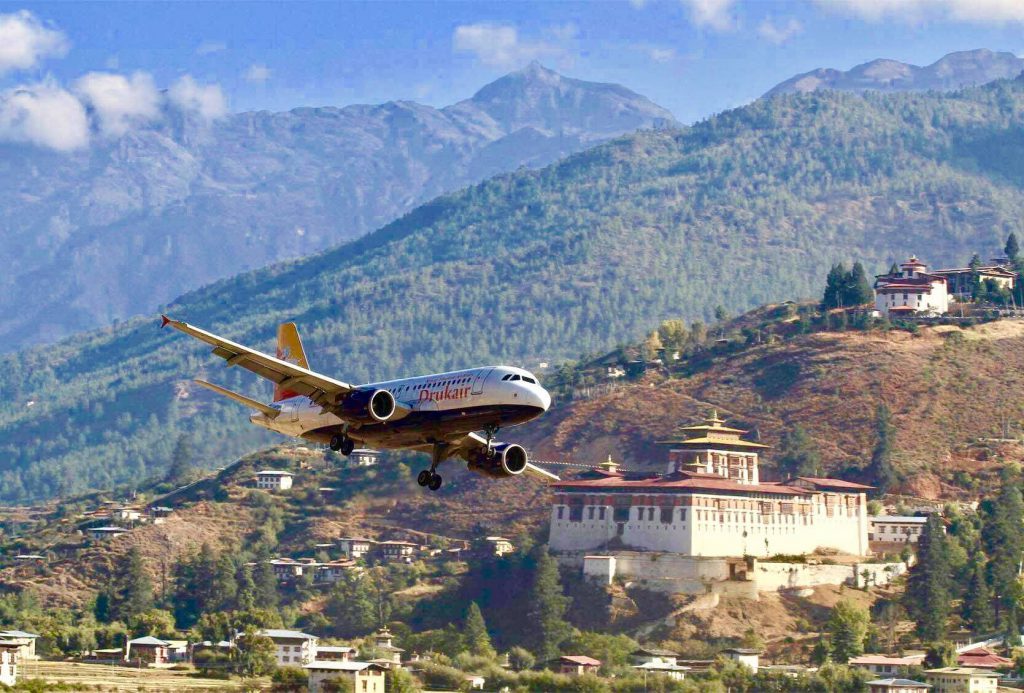
On a clear weather, magnificent views of the world’s highest peaks and lush green Paro valley will be your first gift from Bhutan.You will be welcomed by cool, clean fresh air as you step out of the plane.
After clearing customs and visa control you will meet our guide. Afternoon in Paro visit Ta Dzong, once a watchtower, built to defend Rinpung Dzong during inter-valley wars of the 17th century, Ta Dzong was inaugurated as Bhutan’s National Museum in 1968.
Afterwards, walk down a hillside trail to visit Rinpung Dzong. Built in 1646 by Shabdrung Ngawang Namgyal, the first spiritual and temporal ruler of Bhutan, the Dzong houses the monastic body of Paro, the office of the Dzongda (district administrative head) and Thrimpon (judge) of Paro district.
Later Drive to Thimphu. Distance: 54 k. Driving time: 1 hour.
On way we will stop at Tachog Temple. Built by the Tibetan saint Thangtong Gyalpo who is also known as the Iron chain builder of Bhutan. Arrival to Hotel and rest for a while.
After 5 pm visit the Seat of Government ( Tashicho Dzong Fortress)
Evening leisure time in the Capital town.
Overnight at the hotel in Thimphu.
After breakfast travel to Thimphu and check into your hotel. The full day Thimphu tour includes visit to the following:
Resorts/Hotels: In Thimphu
After breakfast, travel to Punakha through Dochula Pass (3,088m/10,130ft). If you have a clear sky, the view of the Himalayan Mountain ranges is spectacular and you can even see the Gasa Dzong as a white dot in the horizon.
Visit the beautiful 108 chortens built on the hill by Her Majesty Ashi Dorji Wangmo for the security and wellbeing of His Majesty the King of Bhutan.
Travel onto Punakha, the old capital of Bhutan and presently the winter residence of the central monk body. After lunch, walk through the Metshina Village and take a 20-minute walk through the rice fields to the Devine
Madman’s Monastery-Chhimi Lhakhang, famously known for its fertility shrine, where one can receive a special fertility blessing.
Visit the Punakha Dzong, located on the island of the Pho – Chu (male) river and the Mochu (female) river.
Later we will visit the longest suspension bridge in Bhutan. It is around ten minute’s drive from the Dzong.
Overnight at a hotel in Wangdue/Punakha.
After breakfast, drives to Bumthang via Pelela pass at the altitude of 3,150 meters, a wonderful opportunity for photographs.
On way you can see the magnificent Trongsa Dzong, the largest fortress in Bhutan. En-route stops at Chummey village to visit yathra weaving central. Which Yathra are made into colorful scarves, bags, blankets and sweater.
Continue drive to Bumthang.
After check in your can visit the Bumthang town. Bumthang valley is one of the most beautiful valley in Bhutan and it is known as Switzerland of Bhutan, have a local meal in a resorts/Hotels.
Overnight in Bumthang
After breakfast sightseeing in Bhutan are as follows
In the morning visit the Jakar Dzong. The fortress is now used as an administrative centre of the valley and summer residence of monks. (located around 10-15 minute drive from your resort)
Visit Jambay Lhakhang, the 7 th century temple built by the famous Tibetan King Songtshen Gyalpo. Visit Kurjey Lhakhang (Kurjey means, “Body imprint”).
The temple to the right was built by Minjur Tempa in 1652. It was built around the cave in which Guru Rinpoche meditated and left his body imprint.
We will hike to Tamshing temple, and have picnic lunch on way if time permits or we can have a local meal in the town. Later we will visit the famous cheese shop and also try the famous red panda beer.
Option : Kharchu Dratshang, leisure in town or rest at resort.
Resorts/Hotels: In Bumthang.
After breakfast drive to Trongsa. And then Visit Trongsa Dzong – seat of the district administration, built in the 1648.
Option visit Tower of Trongsa -converted into the museum from watch tower that once guarded Trongsa Dzong from internal rebellion, stands in Bhutan’s history.
After lunch drive to Phobjikha after lunch. Phobjikha- is a bowl-shape valley on the western slopes of Black Mountain. Optional: After lunch or in Morning visit Gantey Goenpa – This monastery is a major attraction with an old monastery date back to the 16 century.
Later hike around the valley which is also the winter home to the rare black-necked cranes, which migrate, from remote parts of Tibet, China and Siberia during winter to this valley.
Overnight Resorts/Hotels:At Gangtey.
Today after well rest we will drive to Paro. Sightseeing and photography enroute as per the wishes of the clients.
Option: We will do some sightseeing on way and also stop at Thimphu for while if there are any last minute shopping.
( Note : Thimphu is capital city and there are many shops in the valley, so there are more options to shop and also it is much cheaper here comparing to Paro valley )
Later stroll through the town and rest in Resort.
Resorts/Hotels: Overnight in Paro valley.
Tshog offering, private prayers and meditation at Taktsang.
After breakfast, drive up to the base camp of Taktsang and then hike up to the most famous Monastery in the entire kingdom of Bhutan perched on the edge of a steep cliff, about 900 meters above Paro Valley.
The hike to the viewpoint will take about an hour and it will take 2 hours to the monastery. Lunch at the view point or at Paro town.
Later visit the 7th century Kyichu temple. Farewell dinner and overnight at a hotel in Paro valley.
Option: Visit a farm house in the evening and enjoy the special
Traditional home cooked meals.
Resorts/Hotels: At Paro valley.
In the morning, your tour guide from Bhutan (local Bhutan travel agent) will escort you to Paro International Airport for your departure
Duration: 14 Days, 13 Nights.
Locations: Thimphu, Paro valley, Punakha, Wangdi Phodrang, Bumthang, Mongar,Takila, Tashiyangtse, Yonphula, Yonphula, Phobjikha
Type of Tour: Cultural tour/Adventure.
Highlight: Visit to the Ta Dzong (National Museum), Punakha Dzong, Worlds tallest bronze Buddha statue, Tigers nest hike, Phobjikha Valley, textile tour, east bhutan, Himalayas tallest Guru rimpoche statue, spiritual tour….
Fly into Paro on our national carrier, Druk Air, is a befitting introduction to the spectacular beauty of our country. In clear weather, magnificent views of the world’s highest peaks give way to the lush green Paro valley as you land. First gift from Bhutan will be the cool, clean fresh air as you step out of the plane.
After clearing customs and visa control you will meet our guide and driver.
In the afternoon visit Ta Dzong, once a watchtower, built to defend Rinpung Dzong during inter valley wars of the 17th century, Ta Dzong was inaugurated as Bhutan’s National Museum in 1968.
Afterwards, walk down a hillside trail to visit Rinpung Dzong. Built in 1646 by Zhabdrung Ngawang Namgyal, the first spiritual and temporal ruler of Bhutan, the Dzong houses the monastic body of Paro, the office of the Dzongda (district administrative head) and Drangpoen (judge) of Paro district.
Overnight in Paro.
As per the flight timing, you will be escorted to Paro International airport for the onward departure to Yonphula (Eastern Bhutan) via domestic flight. Guide and driver will receive you from the domestic airport, Yonphula and then enjoy the beautiful view from there. After that drive to Tashigang, one of the biggest district in Bhutan.
Check into the hotel and then visit Tashigang dzong, the fortress which was built in 17th century and has commanding view of the valley. Inside are few interesting temples and local government offices.
(If you arrive early in Tashigang, then drive to Rangjung for the sightseeing).
After the breakfast, drive to Tashiyangtse which will take about 2 hours’ drive time. On the way, visit to the Gomphu Kora temple, place where 8th century magician-saint Guru Padmasambhava left his body imprints. Further drive will offer occasional views of Snowy Mountain in clear weather.
Finally you will see impressive building of the old Trashi Yangtse dzong which is home to 300 monks. The dzong used to protect former trade route with Tibet and was established by the saint Pema Lingpa of 15th century.
The temples with valuable statues are worth of exploring. Also near the Trashi Yangtse is the famous Chorten Kora, the largest stupa in Bhutan built in Nepali style. This is the site of two colorful local festivals at the beginning of the year. Trashi Yangtse is also home to National Institute for Zorig Chusum, the school where the young people learns the art crafts of their forefathers to keep Bhutan’s traditional arts alive.
Evening return to Trashigang.
After breakfast, you will drive to Mongar which will take 31⁄2 hours’ drive but on the way, you can visit Dramtse Gompa, which is one of the most important monasteries of eastern Bhutan.
This is the place from where the famous Naga Chham (mask dance of the drums from Drametse), mask dance with drums originated. This dance is ubiquitous feature of many festivals and also it was included to the UNESCO list of oral and intangible heritage. Monastery itself was founded in 16th century by descendants of the saint Pema Lingpa and its name means “the peak where there is no enemy”.
There is number of interesting chapels with a lot of important statues of the saints and protector deities. After that drive to Mongar and on the way visit Ngatshang monastery. You will also stop for a coffee at Korila pass between before reaching Mongar. After reaching Mongar, you will visit a dzong (castle). Although built in 1930, the dzong maintains Bhutanese architectural traditions.
Morning drive to Lhuntse which is one of the most rural and isolated districts in Bhutan. The landscape is spectacular with stark cliffs and gorges, beautiful conifer and pine forests and remote villages with rice, millet and corn fields.

Kurtoe region of Lhuntse is the ancestral home of Bhutan’s royal family. We will visit Takila, the place where the gigantic statue of Guru Rimpoche was recently built. Inside the statue, you find number of richly decorated chapels, which.
Further you will continue to Khoma village for most elaborate traditional cloths in Bhutan. Quality of weaving is so fine that even Royal Family places their order for clothes here. Village itself is interesting and beautiful so we will spend some extra time here having a lunch in local house and tasting local delicacies.
Then drive back to Mongar for overnight.
The journey continues westwards winding through more rugged terrain. The drive will take minimum 7 hours, but it won’t be boring at all. Road offers most spectacular views in the country ascending 3200 meters in the distance of 84 kilometers.
After about a hour drive, you’ll pass along the ruins of Sengor dzong, which burned to ash in 1899. Chortens on the roadside are built in memory of 300 laborers who died during road building in 1970’s.
You’ll also come along the stunning Namling waterfall. After crossing the second highest motor able pass in Bhutan, the Thrumshing-la (3,580 m), you gradually descend to clustered village of Ura.
It’s good idea to stop at rhododendron garden just after the pass to see the number of species of this beautiful tree. From Ura village we will continue drive to the Shertong-la pass (3580 m). Right after that in sharp turn,
the Gangkhar Punesum, the highest mountain in Bhutan might be seen in clear weather.
Overnight at hotel in Bumthang.
After lunch, we will visit the following:
Overnight at Bumthang
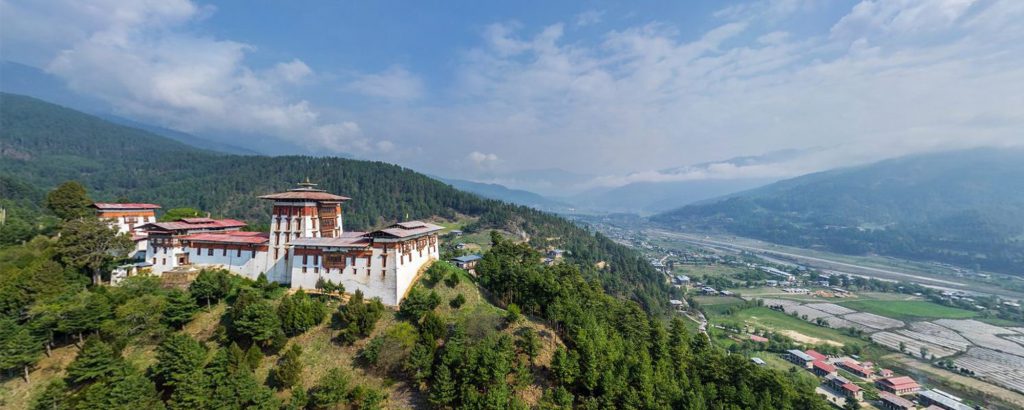
After breakfast, drive to Wangdue/ Punakha via Phobjikha valley. Driving through the dense forests of the Phobjikha Valley you arrive at Gangtey village where you see the Gangtey Monastery and visit the monastery.
Phobjikha valley is part of the beautiful Jigme Singye Wangchuck National Park (formerly known as Black Mountains National Park), one of Bhutan’s most important nature sanctuaries.
Each winter it is home to a flock of 300 rare and endangered black-necked cranes. The surrounding hills and mountains are home to nomadic shepherds and yak-herders. After lunch at Gangtey and explore Phobjikha valley and also visit the Black Necked Crane Center.
Dinner and overnight at Gangtey valley with natural view.
Today after breakfast we will drive to Punakha valley with sightseeing en-route. We will stop at certain places for tea/refreshments and drive slowly towards Punakha valley.
Punakha was the winter capital for over 300 years until the time of second King. Punakha Dzong, which dominates the whole area, was built in 1637 by Zhabdrung Ngawang Namgyel, and established the central monastic body with 600 monks.
Visit Punakha suspension bridge. Punakha suspension Linking Punakha Dzong to Shengana, Samdingkha, and Wangkha villages across the Tsang Chu River (aka Po Chu), this is one of the longest suspension bridges in Bhutan.
It is roughly 160 meters long suspension bridge, it’s surprisingly stable. The bridge offers a spectacular view of the river and valley, and the east bank is a good starting point for multi-day treks in the nearby mountains.
Overnight Punakha at Hotel.
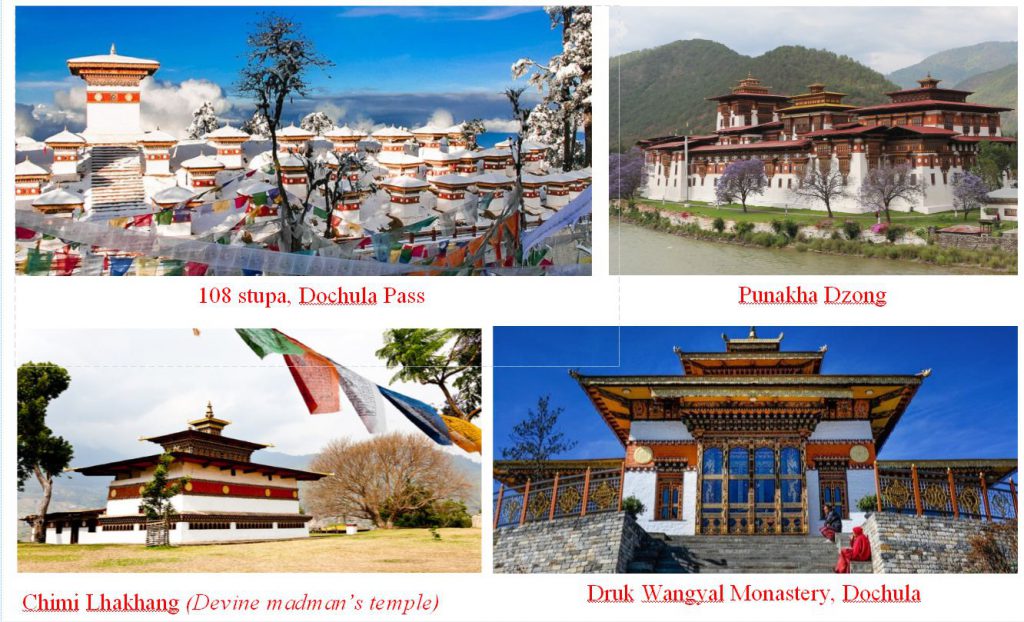
After breakfast, we will drive through upper Punakha valley passing through farm houses and take a leisure walk through farmhouses to the beautiful Khamsum Yuelley Namgyal Lhakhang (temple) built by Ashi Tshering Yangdon Wangchuck (the Queen Mother of Bhutan) for peace and stability in this ever changing world.
The leisurely walk up to the temple would take about an hour.
After lunch, we will travel to Thimphu and on the way we will visit Devine Madman’s temple (Chimi Lhakhang). Before arriving in Thimphu you come across Dochula (Dochula Pass 3140m).
In the clear sky, enjoy the panoramic view of Himalayan Mountain ranges. Then pass by the beautiful 108 chortens (Stupa) built on the hill by Her Majesty Ashi Dorji Wangmo Wangchuck (Queen Mother of Bhutan) for the security and well being of His Majesty, the King of Bhutan.
Overnight at Punakha.
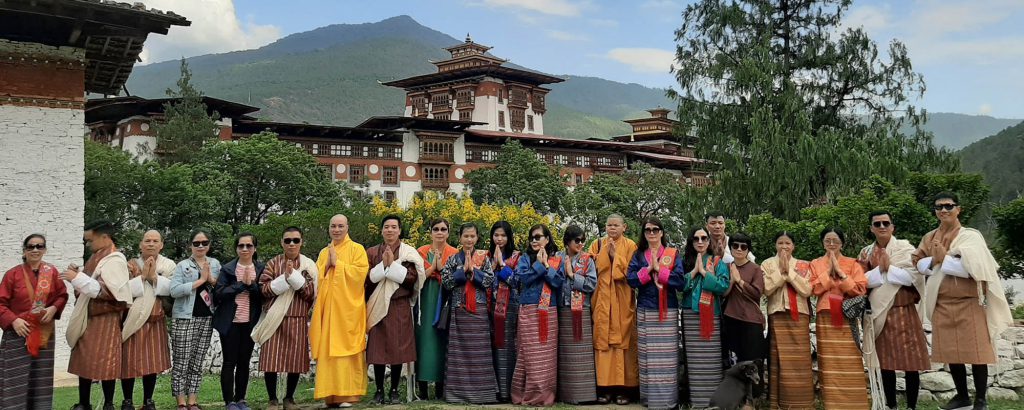
After breakfast visit Kuensel phodrang (commonly known as Buddha Point) where the largest Buddha statue in the country is perched on the hillock overlooking the Thimphu Valley. You may take a nature hike through Kuensel Phodrang Nature Park.
Then visit, National Memorial Chorten (stupa) which was constructed in 1974 as a memorial for the third King of Bhutan, King Jigme Dorji Wangchuck. After lunch visit the following:
Dechenphodrang (meaning, Palace of great bliss) Monastery located at north of Thimphu valley. It is a monastic school for about 500 young monks enrolled for 8 years courses.
You will visit the monastery and have free interaction with young monks who are mostly from poor family ground and some even orphan. The “Palace of Great Bliss‟ serves as a home and learning center for these young monks. You will spend some time interacting with young monks.
Tashichhoe Dzong, a fortress of the glorious religion. It was built in 1641 by Zhabdrung Ngawang Namgyel and was reconstructed into present structure by the late King, His majesty Jigme Dorji Wangchuck in the year 1962-1969. It houses the secretariat building, the throne room and the office of the king, and the central monk body.
Centenary farmer’s market where the farmers/locals sells their organic farm produces.
Overnight at Thimphu.
Have breakfast in hotel and then visit the following:
After lunch, visit weaving Center at Changzamtog and continue with the drive to Paro.
Check into the hotel and then visit small Paro town for shopping if you wish. Overnight at Paro.
After breakfast, drive up to the base camp of Taktsang and then hike up to the most famous Monastery in the entire kingdom of Bhutan perched on the edge of a steep cliff, about 900 meters above Paro Valley.
The hike to the viewpoint will take about an hour and it will take 2 hours to the monastery. Till view point, you can experience horse ride by paying USD 15 to USD 20 per horse but if you prefer hike, then it is great.
Lunch at Taktshang Café just above view point or you can have picnic lunch.
After completing the hike, you will be visiting one of the farm houses in Paro to experience Bhutanese life-Style and the organic Bhutanese dinner.
You can also experience hot-stone bath at farm house (US $ 20 /25per person).
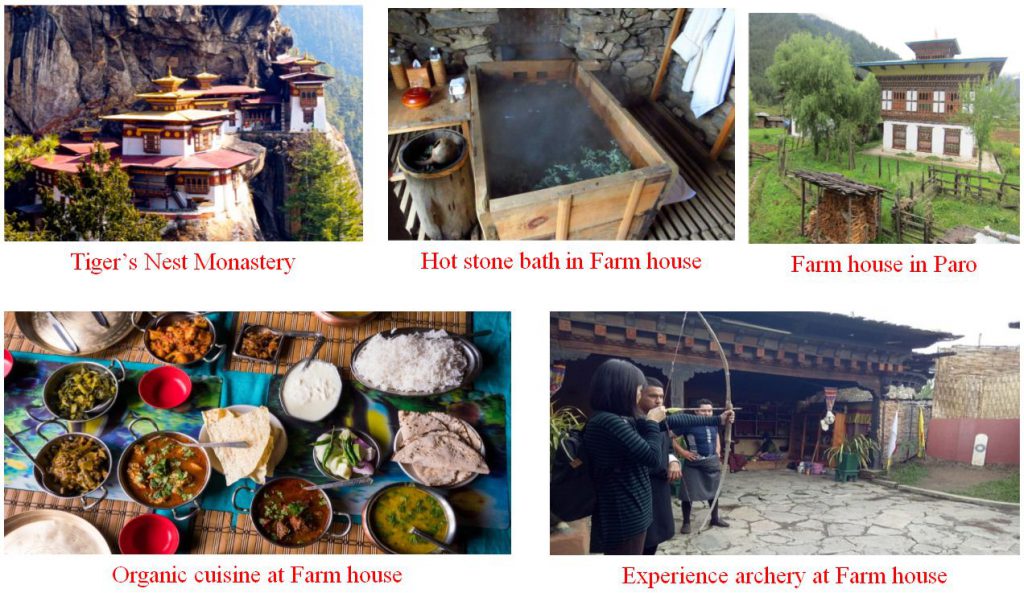
In the morning, your tour guide from Yelha Bhutan Tours & Travels (local Bhutan travel agent) will escort you to the airport for your onward destinations.
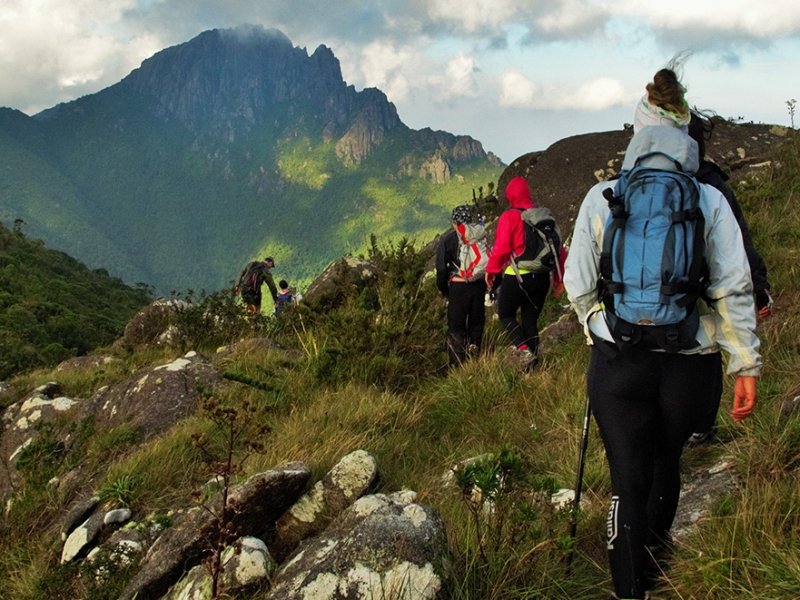
Description : This six day trek takes you into an area adorned with a multitude of pristine, crystal clear lakes.
As you walk amidst the shimmering lakes you’ll be treated to stunning views of the entire Himalayan mountain range and some of the world’s highest peaks including Mt. Everest, Jomolhari, Masang Gang, Jichu Drake, Gangche Ta and many more.
During the trek an entire day will be dedicated to visiting some of the more picturesque lakes and resting. The trail also takes you through several Bhutanese villages so you can get a good idea of traditional Bhutanese village life as you make your way back from the lakes.
While this is a somewhat strenuous trek, it is well worth the effort because of the tranquility and beauty of natural landscape that you will enjoy during the journey. The best time to embark on this trek is between April-June or September –October
DAY 1: ARRIVE PARO, SIGHTSEEING
Fly into Paro by Druk Air, Bhutan’s National Airline. The great snow-capped peaks of the inner Himalayas rise up to the heavens can be seen during clear weather. As the plane approaches Bhutan, if you look down farm houses as dots on the hillsides can be seen.
You will be received by the representative of Yelha Bhutan Tours and Travels (Bhutan tour operator) who will be your Bhutan travel guide throughout your tour.
After meeting with the guide and driver, drive to hotel and visit Paro Rinpung dzong, built in 1645 to defend the valley against Tibetan invaders. The Dzong is now being used as an administration center and school for monks. Visit Taa dzong which was built in the 17th century as a watch tower for the Paro Dzong. This dzong was converted into the National museum in 1967.
Overnight at Paro

The route is part of the original mule track that linked Thimphu Valley with Paro Valley and ultimately connected Bhutan to the Indian border. The walk is always done from Paro to Thimphu, as baggage horses are only available in Paro. It is a much more exciting way of reaching Bhutan’s capital and after five days’ trekking the sense of anticipation is keenly felt.
The walk starts appropriately behind Paro Dzong itself. Starting from the watchtower, the path winds its way slowly and evenly upward, through the forest towards the ridge line of the Himalayan foothills above. As the day passes, the views below of the highly cultivated Paro Valley, the Queen Mother’s Winter Palace, and the monastery/fortress itself are wonderful.
The walk is firstly through pine, then bamboo, followed by birch and finally rhododendron. You may have lunch near a Mani wall. The camp site is just a few hundred feet below Jili Dzong in a clearing. You will see plenty of interesting flora and fauna throughout the day and many interesting birds.
It is a short twenty minute hike from the camp to the dzong. This is a large monastery and supposedly haunted. It contains a huge statue of Padma Sambhava.
There are birds nesting in the arrow slits and old Mongol helmets and shields hanging on the walls. The building was until very recently deserted, but has now undergone some renovation and is in use again.
It sits astride a ridge, which affords dramatic views of the valleys on both sides and the Himalaya to the north. On a clear day the second highest mountain in Bhutan can be seen, Mt. Chomolhari, 7,314m.
The path now follows a ridge for a short while before descending into forest. It then follows a snake-like route on rather magical paths, along mountainsides and through many different types of rhododendron. Occasionally you may meet local yak herdsmen and take in wonderful views of mountains, including another large peak called Kangcheeta.
You will see this mountain has two peaks and is split by a straight, pronounced gully, locals believe that Kangcheeta is the brother of Chomolhari (female mountain goddess) who hit him with a stick because he wanted to marry her.
To the south, the Dagala range dominates the skyline. Below Mt. Kangcheeta there is a temple, Tshomphu Monastery, where an idol is supposed to float in the air.
In the past our guides said they had visited the temple and it was possible to pass a string underneath the statue, thus proving it floated. Eventually, you pass through a number of yak herder clearings, stopping for the night at the largest of them.
From camp the path ascends to gain the ridge and then traverses along it, first one side and then the other, with wonderful mountain views.
Eventually you cross a small pass and circle round, until above Jimi Langtsho Lake. This is a large beautiful lake, stocked with trout, with a large chorten (religious obelisk) built at one end. You zigzag down to the lakeside, which is thick with rhododendron and hemmed in by rocky bluffs.
The path then leads up from the lake and along cliff paths with massive drops below. Eventually it leads round a succession of ridges until you arrive at the second lake, Jana Tsho, another magical campsite.
Again a lovely walk in glorious high mountain country, crossing the highest pass, the Simkota La 4,210m/13,812ft. From the lake a wide stone path between rhododendrons leads to traversing a basin, which contains the 3rd lake. Two other lakes are above and out of sight, one male, one female and collectively they are called Dungkar Tsho.
The latter of these has a very strong spirit and if anything ‘dirty’ is done nearby cloud comes down and only goes away with many prayers. The path is a mixture now of small passes, mountain tracks, some of which wander underneath cliffs. You may meet monks on their way from Thimphu to
visit the sacred lake of Jimi Langtsho, where they meditate for a few days before returning. The rocky mountain next to the highest pass, Thujedraj, used to be used for sky burials in the old days. Lower down there is one smaller pass with a chorten which looks directly down onto Thimphu.
Here you will have lunch (31⁄2 hours to here) and then the path zigzags down to Phadjoding. There is time to rest, wash and then see the temples. There is a recent one, constructed with funds donated by the 4th King’s
Secretary, dedicated to Padma Sambava, but the 9th and 16th Je Khempos (head monk of Bhutan) built the two main ones. These are gorgeous buildings with golden roofs and acolyte monks will show you the inner temples.
Phadjoding is a great meditation centre and there are a number of houses dedicated to retreat. A particular type of branch is put outside the front door, showing that the incumbent is not to be disturbed. High up on the cliff behind Phadjoding is a famous hermit temple, built many hundreds of years ago and still used today.
It only takes two or three hours to reach the road, descending, steeply at times, through the forest, on a well worn path. It is worth getting up early for the clear views of the Eastern Himalaya.
Seen clearly on the horizon behind the temples is the highest mountain in Bhutan, Gangkar Punsum, at 7,550m/24,770ft now the highest unclimbed peak in the world. There are several paths leading down to Thimphu; perhaps the best is the one leading to the Radio Station, which takes about 3 hours. Quite often the valley below may be filled with cloud, with just the mountains poking up into the clear air.
Your vehicle will meet you at the road head for the short transfer to your hotel in town.
After reaching Thimphu, check into the hotel and take shower or rest for a while and stroll through through Thimphu town in the evening.
After breakfast we have a full day Thimphu tour which includes visit to the following:
In the afternoon drive to Paro.
Overnight at a hotel in Paro.
After breakfast, drive up to the base camp of Taktsang and then hike up to the most famous Monastery in the entire kingdom of Bhutan perched on the edge of a steep cliff, about 900 meters above Paro Valley.
The hike to the viewpoint will take about an hour and it will take 2 hours to the monastery. Till view point, you can experience horse ride by paying USD 15 to USD 20 per horse but if you prefer hike, then it is great.
Lunch at Taktshang Café just above view point or you can have picnic lunch.
After completing the hike, you will be visiting one of the farm houses in Paro to experience Bhutanese life-Style and the organic Bhutanese dinner.
You can also experience hot-stone bath at farm house (US $ 20 per person).
It is a good remedy for skin diseases, joint pains, body aches and to relax after a hard day’s work.
No scientific study has been done but it’s believed that the herbs and the chemical in the stones are a good source of medicine. Families in olden days would soak after their seasonal farm work in winter. The long, healing bath relaxed their tired bodies and helped cure backaches and joint pains.
In the evening relax and overnight at a hotel in Paro.

In the morning tour guide from Yelha Bhutan Tours will escort you to the Paro airport for your flight to your onward destinations.